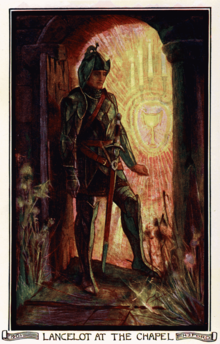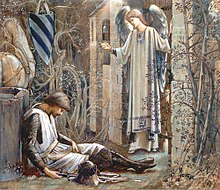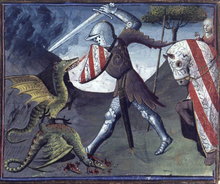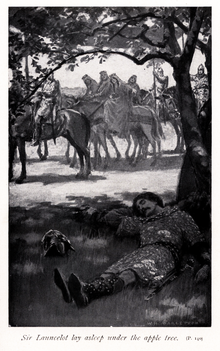Lancelot
| Lancelot | |
|---|---|
Matter of Britain character | |
 | |
| First appearance | Erec and Enide |
| Created by | Chrétien de Troyes |
| Information | |
| Occupation | Knight of the Round Table |
| Title | Sir |
| Family | King Ban, Elaine of Benoic, Lady of the Lake, Hector de Maris |
| Significant other(s) | Queen Guinevere, Elaine of Corbenic |
| Children | Galahad |
Sir Lancelot du Lac (meaning Lancelot of the Lake), alternatively also written as Launcelot and other spellings, is one of the Knights of the Round Table in the Arthurian legend. He typically features as King Arthur's greatest companion, the lord of Joyous Gard and the greatest swordsman and jouster of the age – until his adulterous affair with Queen Guinevere is discovered, causing a civil war exploited by Mordred which brings about the end of Arthur's kingdom. His first appearance as a main character is in Chrétien de Troyes' poem Lancelot, the Knight of the Cart, written in the 12th century. Later, his exploits were expanded upon in the Prose Lancelot, which was further expanded upon for the vast Lancelot-Grail cycle. There, his and Lady Elaine's son, Galahad, becomes an even more perfect knight.
Contents
1 History
1.1 Origins
1.2 Early appearances
1.3 Later amplifications and versions
2 In French prose romances and Le Morte d'Arthur
2.1 Birth and childhood
2.2 Arthur and Guinevere
2.3 Galahad and the Grail
2.4 Later years and death
3 In modern media
4 References
5 Bibliography
6 External links
History

Lancelot slaying a firebreathing dragon in Arthur Rackham's illustration for Tales of King Arthur and the Knights of the Round Table (1917)
Origins
Roger Sherman Loomis suggested that Lancelot is related to either the character Llenlleog (Llenlleawg) the Irishman from Culhwch and Olwen (which associates him with the "headland of Gan(i)on") or the Welsh hero Llwch Llawwynnauc (probably a version of the euhemerized Irish deity Lugh Lonbemnech), possibly via a now-forgotten epithet like "Lamhcalad".[1][2] Traditional scholars thought that they are the same figure due to the fact that their names are similar and that they both wield a sword and fight for a cauldron in Preiddeu Annwn and Culhwch.
Modern scholars are less certain. The name may have been an invention by the 12th-century French poet Chrétien de Troyes. Another theory is that the name may have been derived from Geoffrey of Monmouth's Anguselaus. Lancelot may be also a variant of the name Lancelin.[3] Lancelot or Lancelin may instead have been the hero of an independent folk tale which had contact with and was ultimately absorbed into the Arthurian tradition. The theft of an infant by a water fairy, the appearance of the hero at a tournament on three consecutive days in three different disguises, and the rescue of a queen or princess from an Otherworld prison are all features of a well-known and widespread tale, variants of which are found in almost every land and numerous examples of which have been collected by Theodore Hersart de la Villemarqué in his Barzaz Breiz, by Emmanuel Cosquin in his Contes Lorrains, and by John Francis Campbell in his Tales of the West Highlands.
Early appearances
In Chrétien de Troyes's earliest known work Erec and Enide, the name Lancelot appears as third on a list of knights at King Arthur's court. The fact that Lancelot's name follows Gawain and Erec indicates the presumed importance of the knight at court, even though he did not figure prominently in Chrétien's tale. Lancelot reappears in Chrétien's Cligès, in which he takes a more important role as one of the knights that Cligès must overcome in his quest.[4]

N. C. Wyeth's illustration for The Boy's King Arthur: Sir Thomas Malory's History of King Arthur and His Knights (1922): "Sir Mador [de la Porte]'s spear brake all to pieces, but [Lancelot's] spear held."
It is not until Chrétien's Lancelot, the Knight of the Cart (Le Chevalier de la Charrette), however, that Lancelot becomes the protagonist. It is also Chrétien who first gives Lancelot the name Lancelot du Lac (Lancelot of the Lake),[5] which was later picked up by the French authors of the Lancelot-Grail and then by Thomas Malory.[6] He is presented as the most formidable and the bravest knight at King Arthur's court, and one whom everyone is forced to describe as uniquely perfect: his deeds are recounted for their uniqueness, not only among living knights but of all men who have ever lived.[7] However, this supposed saint-like perfection stands at stark contrast with his adulterous relationship with King Arthur's wife Queen Guinevere, which motif too has been introduced in this text.[1] Their affair can be seen as parallel to that of Tristram (or Tristan) and Iseult, with him ultimately identified with the tragedy of chance and human failing that is responsible for the downfall of the Round Table.[8]
The theme of Lancelot's adulterous passion for Guinevere is entirely absent from another early work, Lanzelet, a Middle High German epic poem by Ulrich von Zatzikhoven dating from the very end of the 12th century (no earlier than 1194). Ulrich asserts that his poem is a translation from an earlier French work, the provenance of which is given and which must have differed markedly in several points from Chretien's Le Chevalier de la Charrette. In Lanzelet, the abductor of Ginover (Guinevere) is named as King Valerin, whose name (unlike that of Chrétien's Meleagant) does not appear to derive from the Welsh Melwas. Furthermore, her rescuer is not Lancelot, who, instead, ends by finding happiness in marriage with the fairy princess Iblis. It has been suggested that Lancelot was originally the hero of a story independent of the adulterous love triangle and perhaps very similar to Ulrich's version. If this is true, then the adultery motif might either have been invented by Chrétien for his Chevalier de la Charrette or been present in the (now lost) source provided him by his patroness, Marie de Champagne, a lady well known for her keen interest in matters relating to courtly love.[9][10]
Lancelot is constantly tied to the Christian motifs associated with Arthurian legend. Lancelot's quest for Guinevere in Lancelot, the Knight of the Cart is similar to Christ's quest for the human soul.[7] This becomes intensified when he becomes the prophesied saviour of the captives of Logres. His adventure among the tombs is described in terms that suggest Christ's "harrowing of Hell" and resurrection: he effortlessly lifts the lid off the sarcophagus, which bears an inscription foretelling his freeing of the captives.[11]

The Earthly Paradise (Sir Lancelot at the Chapel of the Holy Grail) by Edward Burne-Jones (1890s)
Lancelot was later associated with the Grail Quest, but Chrétien does not include him at all in his final romance Perceval, le Conte du Graal. This story introduces the Holy Grail motif in medieval literature, and Perceval is the sole seeker of the Grail in Chrétien's treatment. Lancelot's involvement in the Grail legend is first recorded in the romance Perlesvaus written between 1200 and 1210.[12]
Later amplifications and versions

Lancelot fighting the two dragons guarding the entrance to Morgan's Val without return in a 15th-century French illumination of a Lancelot-Grail manuscript. The arms attributed to him: argent with three bendlets gules
Lancelot's character is perhaps most fully developed during the 13th century in the Old French Vulgate Cycle, where he appears prominently in the third and fourth parts, known as the Prose Lancelot (or Lancelot du Lac) and the Queste del Saint Graal (or The Quest for the Holy Grail) respectively. Gaston Paris argues that the Guinevere-Meleagant episode of the Prose Lancelot is an almost literal adaptation of Chrétien's poem, though the Prose Lancelot can be seen as a considerable amplification of Chrétien's tale. Chrétien treats Lancelot as if his audience were already familiar with the character's background, yet most of the exploits that are today associated with Lancelot are first mentioned here (e.g. Lancelot's parentage; Lancelot and the Grail; Lancelot, Guinevere and the fall of Camelot).
The Middle Dutch so-called Lancelot Compilation (The Hague, KB129 A 10) contains seven Arthurian romances folded into the three parts of the cycle. Lanceloet en het hert met het witte voet ("Lancelot and the hart with the white foot") is an original romance in which Lancelot fights seven lions to get the white foot from a hart (deer) which will allow him to marry a princess. The creation of a new story indicates Lancelot's widespread popularity.[13]
In French prose romances and Le Morte d'Arthur

N. C. Wyeth 1922: "I am Sir Launcelot du Lake, King Ban's son of Benwick, and knight of the Round Table."
Birth and childhood

Howard Pyle's illustration for The Story of the Champions of the Round Table (1905): "The Lady Nymue beareth away Launcelot into the Lakes."
Lancelot is the son of the French King Ban of Benwick (or Benoic) and Elaine.[14] While Lancelot is an infant, his father is driven from his kingdom in Britain by his enemy Claudas de la Deserte. Ban and Elaine flee, carrying the child with them. As Elaine is tending to her wounded husband, Lancelot is carried off by the Lady of the Lake who raises the child in her magical kingdom. It is from this upbringing that Lancelot earns the surname du Lac ("of the Lake").
Lancelot's double-cousins Lionel and Bors, sons of King Bors of Gaunnes and Elaine of Benoic's sister Evaine, are first taken by a knight of Claudas and later spirited away to the Lady of the Lake. They become Lancelot's companions. Both Evaine and Elaine enter a nunnery. Following a vision of Lancelot and his cousins in the Lady of the Lake's garden, both queens are happy and Evaine dies.[15]
Arthur and Guinevere

N. C. Wyeth 1922: "He rode his way with the Queen unto Joyous Gard."
The Lady of the Lake sends Lancelot to King Arthur's court where he becomes a knight at the behest of Sir Gawain. Almost immediately upon his arrival, Lancelot falls in love with the Queen, and one of his very first adventures is rescuing Guinevere from Arthur's enemy Meleagant (in Le Chevalier de la Charette). The episode seems to be related to a Celtic abduction tale called the aithed. In this legend, a mysterious stranger kidnaps a married woman and takes her to his home; the husband of the woman then rescues her against insurmountable odds.[16] The exact timing and sequence of events varies from one source to another, and some details are only found in certain sources. For example, in Malory's Le Morte d'Arthur, the adulterous relationship is postponed for several years, and the rescue takes place after the adventures of the Holy Grail.[1]
Lancelot plays an important role in a war between Arthur and Galehaut (Galahaut). Galahaut is Arthur's enemy and poised to become the victor, but he is taken by Lancelot's battlefield performance and offers him a boon in return for the privilege of one night's company in the bivouac. Lancelot accepts and uses his boon to demand that Galahaut surrender peacefully to Arthur. Initially, Lancelot continues to serve Galahaut, but eventually Arthur invites Lancelot to become a member of the Round Table, and Galahaut as well. In spite of this happy outcome, Galahaut is the one who finally convinces Guinevere that she may return Lancelot's affection, an action that at least partially results in the fall of Camelot.[1]
Later, with the help of King Arthur, Lancelot defeats Claudas and recovers his father's kingdom. However, he again decides to remain at Camelot with his cousins Sir Bors and Sir Lionel and his illegitimate half-brother Ector de Maris (Hector).[1] Lancelot's own castle in Britain is known as Joyous Gard.
Galahad and the Grail

Morgan, Sebile and two other witch queens find Lancelot sleeping in William Henry Margetson's illustration for Legends of King Arthur and His Knights (1914)
Lancelot became one of the most famous Knights of the Round Table and an object of desire by many ladies. Faithful to Queen Guinevere, he refuses the forceful advances of Queen Morgan le Fay, Arthur's enchantress sister constantly attempting to seduce Lancelot, whom she at once greatly loves and hates with the same intensity, and even kidnapping him on occasions (including once when she does it together with her fellow magical queen, Sebile). Another sorceress, Hellawes, wants him for herself so obsessively that, failing in having him either dead or alive, she soon herself dies from sorrow. Similarly, Elaine of Astolat too dies of heartbreak due to her unrequited love of Lancelot.

N. C. Wyeth 1922: "And lived by fruit and such as he might get."
Elaine of Corbenic, daughter of the Fisher King, also falls in love with him, and she is more successful than the others. With the help of magic, Elaine tricks Lancelot into believing that she is Guinevere and he sleeps with her, and the ensuing pregnancy results in the birth of his son, Galahad.[1][17] Guinevere eventually learns of that affair and is furious. She criticizes Lancelot for his behavior and banishes him from Camelot. Broken by Guinevere's reaction, Lancelot goes mad and wanders the wilderness for years until he arrives at Corbenic where he is recognized by Elaine; Lancelot is shown the Holy Grail through a veil which cures his madness. (Alternatively, he is found and healed by the Lady of the Lake.[18]) Shortly after he recovers, he returns to Camelot after being found by Sir Percival and Sir Ector, who were both told to look for him by Guinevere.
Upon his return to court, Lancelot takes part in the Grail Quest with Percival and Galahad, though he is only allowed a glimpse of the Grail itself because he is an adulterer and distracted by earthly honours that have come with his knightly prowess. It is instead his son Galahad who ultimately achieves the Grail to drink from, along with Lancelot's cousin Sir Bors and Sir Percival, the son of King Pellinore.[1]
Later years and death
Ultimately, Lancelot's affair with Guinevere is a destructive force.[19] Once finally revealed by Morgan, it results in the death of two of Gawain's brothers, Gaheris and Gareth, at Lancelot's hand during his and Ector's violent rescue of Guinevere from being burned at the stake for her infidelity, a war waged against Lancelot by the vengeful Gawain and King Arthur in France, and Mordred's betrayal of Arthur to seize the throne for himself.[1]
Upon hearing the news of Arthur's death by Mordred at Camlann, Lancelot returns to Britain, where he kills a son of Mordred and finds that Guinevere has become a nun.[11][20] She blames all the destruction of the Round Table upon their adulterous relationship, which is the seed of all the dismay that followed, according to Le Morte d'Arthur. She refuses to kiss Lancelot one last time, telling him to return to his lands and that he will never see her face again. Instead, Lancelot declares that, if she will take a life of penitence, then so will he.

N. C. Wyeth 1922: "Sir Launcelot saw her visage, but he wept not greatly, but sighed."
Lancelot then retires to a hermitage to live the remainder of his life in penitence, with eight of his kin joining him, including Sir Bors. Eventually, he becomes a priest, later conducting rites over the deceased body of Guinevere (who had become an abbess). As she had indicated, he never saw her face again in life. He had a dream warning him that she was dying, so he set out to visit her. But Guinevere prayed that she might die before he arrived, and so she did, half an hour before his arrival.
After the queen's death, Lancelot and his fellow knights escort her body to be interred beside King Arthur (it was in the same place that Gawain's skull was kept). Lancelot's health then begins to fail, as he is distraught for the loss of his beloved king and queen. In fact, even before this time, Le Morte d'Arthur states that he had lost a cubit of height due to his penitent fastings and prayers. Lancelot dies six weeks after the death of the queen. It is implied that he wished to be buried beside the king and queen; however, he had made a vow some time before to be buried at Joyous Gard, so he asks to be buried there so as not to break his word. His eight companions, who had joined Lancelot in a life of penitence, return to France in order to take care of the affairs of their lands after his death, according to Le Morte d'Arthur. Then, acting on Lancelot's death-bed request, they go to the Holy Land and fight against the Muslims; there they die on Good Friday, while battling the Moors.
In modern media
Lancelot appeared as a character in many Arthurian films and television productions. He was played by Robert Taylor in Knights of the Round Table (1953), William Russell in The Adventures of Sir Lancelot (1956–1957), Robert Goulet in Camelot (1960), Cornell Wilde in Sword of Lancelot (1963), Franco Nero in Camelot (1967), Luc Simon in Lancelot du Lac (1974), John Cleese in Monty Python and the Holy Grail (1975), Nicholas Clay in Excalibur (1981), Richard Kiley in The Last Defender of Camelot (1986), Richard Gere in First Knight (1995), Jeremy Sheffield in Merlin (1998), Michael Vartan in The Mists of Avalon (2001), Ioan Gruffudd in King Arthur (2004), Hank Azaria in Spamalot (2005), Phil Cornwell in King Arthur's Disasters (2005–2006), Thomas Cousseau in Kaamelott (2005–2009), Santiago Cabrera in Merlin (2008–2011), Christopher Tavarez in Avalon High (2010), Sinqua Walls in Once Upon a Time (2012, 2015), Dan Stevens in Night at the Museum: Secret of the Tomb (2014), and Martin McCreadie in Transformers: The Last Knight (2017), among others.
- Lancelot is a major character in Bernard Cornwell's trilogy of novels The Warlord Chronicles. This version of Lancelot is depicted as a self-serving prince of Benoic who eventually becomes a major enemy of Arthur and the novels' main protagonist Derfel Cadarn, and presents his positive depiction in legend as merely an influence of the poets that had been hired by Lancelot's mother.
- Lancelot is the primary antagonist in the first season of The Librarians, portrayed by both Matt Frewer and Jerry O'Connell. He gained immortality sometime after the fall of Camelot through magic, and has spent centuries seeking to reverse the events that brought about its destruction. As the mysterious Dulaque, he leads the Serpent Brotherhood, a cult that has long opposed the Library's mission to keep magic out of the hands of humans.
- Lancelot appears in the light novel and its 2011 anime adaptation Fate/Zero as the Servant "Berserker", played by Ryōtarō Okiayu/Kyle Herbert.
Jason Griffith portrayed him in the video game Sonic and the Black Knight (2009) in Lancelot's appearance is based on Shadow the Hedgehog.
Sophie Cookson's character in the comic book and film Kingsman: The Secret Service has the code name Lancelot.- Lancelot is a principal character in the 2005 Broadway musical Spamalot. Following the plot of Monty Python and the Holy Grail, he rescues Prince Herbert of Swamp Tower from his homophobic father and the two fall in love, eventually marrying each other during the finale number. Actor Hank Azaria was nominated for a Tony Award for "Best Performance by a Leading Actor in a Musical" for his performance as Lancelot.
Giles Kristian's novel "Lancelot", was published in 2018 as an original telling of the Lancelot story.- Lancelot is a playable character in the mobile game Mobile Legends: Bang Bang.[21]
References
^ abcdefgh Sir Lancelot, Biography : Lancelot Archived 2012-03-08 at the Wayback Machine.
^ Bruce, Christopher W (1998). The Arthurian name dictionary. Lancelot: Routledge. p. 305. ISBN 978-0-8153-2865-0..mw-parser-output cite.citation{font-style:inherit}.mw-parser-output q{quotes:"""""""'""'"}.mw-parser-output code.cs1-code{color:inherit;background:inherit;border:inherit;padding:inherit}.mw-parser-output .cs1-lock-free a{background:url("//upload.wikimedia.org/wikipedia/commons/thumb/6/65/Lock-green.svg/9px-Lock-green.svg.png")no-repeat;background-position:right .1em center}.mw-parser-output .cs1-lock-limited a,.mw-parser-output .cs1-lock-registration a{background:url("//upload.wikimedia.org/wikipedia/commons/thumb/d/d6/Lock-gray-alt-2.svg/9px-Lock-gray-alt-2.svg.png")no-repeat;background-position:right .1em center}.mw-parser-output .cs1-lock-subscription a{background:url("//upload.wikimedia.org/wikipedia/commons/thumb/a/aa/Lock-red-alt-2.svg/9px-Lock-red-alt-2.svg.png")no-repeat;background-position:right .1em center}.mw-parser-output .cs1-subscription,.mw-parser-output .cs1-registration{color:#555}.mw-parser-output .cs1-subscription span,.mw-parser-output .cs1-registration span{border-bottom:1px dotted;cursor:help}.mw-parser-output .cs1-hidden-error{display:none;font-size:100%}.mw-parser-output .cs1-visible-error{font-size:100%}.mw-parser-output .cs1-subscription,.mw-parser-output .cs1-registration,.mw-parser-output .cs1-format{font-size:95%}.mw-parser-output .cs1-kern-left,.mw-parser-output .cs1-kern-wl-left{padding-left:0.2em}.mw-parser-output .cs1-kern-right,.mw-parser-output .cs1-kern-wl-right{padding-right:0.2em}
^ Goulven Péron, "La légende de Lancelot du Lac en Anjou". Les Cahiers du Baugeois, n°92 (March 2012), pp. 55–63,
ISSN 0999-6001.
^ Bruce, Christopher W (1998). The Arthurian name dictionary. Lancelot: Routledge. pp. 305–306. ISBN 978-0-8153-2865-0.
^ William Farina, Chretien de Troyes and the Dawn of Arthurian Romance (2010). Page 13: "Strictly speaking, the name Lancelot du Lac (“Lancelot of the Lake”) first appears in Chrétien's Arthurian debut, Erec and Enide (line 1674), as a member of the Roundtable."
^ Elizabeth Archibald, Anthony Stockwell Garfield Edwards, A Companion to Malory (1996). Page 170: "This is the book of my lord Lancelot du Lac in which all his deeds and chivalric conduct are contained and the coming of the Holy Grail and his quest (which was) made and achieved by the good knights, Galahad."
^ ab Raabe, 1987.
^ MacBain, 1993.
^ Arthurian Literature in the Middle Ages : A Collaborative History ed. Roger Sherman Loomis, pub. Oxford University Press 1959, special edition for Sandpiper Books Ltd. 2001,
ISBN 0 19 811588 1 pp. 436–9 in Essay 33 Hartmann von Aue and his Successors by Hendricus Spaarnay.
^ Schultz, James A. (1991). "Ulrich von Zatzikhoven". In Norris J. Lacy, The New Arthurian Encyclopedia, pp. 481–482. New York: Garland.
ISBN 0-8240-4377-4.
^ ab Pyle, Howard (1993). King Arthur and the Knights of the Round Table. New York City, New York: Waldman Publishing Corporation. p. 238. ISBN 0-86611-982-5.
^ Joe, Jimmy. "Grail Legends (Perceval's Tradition)". www.timelessmyths.com. Retrieved 2018-05-29.
^ Brandsma, Frank (1998). "Lancelot". In Gerritsen, Willem P.; van Melle, Anthony G.; Guest, Tanis (trans.). A Dictionary of Medieval Heroes. Boydell and Brewer. pp. 160–70. ISBN 085115381X.
^ Lancelot at the Camelot Project. Archived 2008-12-10 at the Wayback Machine.
^ Lacy, Norris J. (Ed.) (1995). Lancelot–Grail: The Old French Arthurian Vulgate and Post-Vulgate in Translation, Volume 3 of 5. New York: Garland.
^ Kibler, William W., The Romance of Arthur, New York & London, Garland Publishing, Inc. 1994 p. 121
^ Mike Ashley, Michael Ashley (2005). The Mammoth Book of King Arthur. Running Press. p. 582. ISBN 978-0-7867-1566-4.
^ "BnF - La légende du roi Arthur". expositions.bnf.fr (in French). Retrieved 2018-10-07.
^ Dover, Carol (2003). A Companion to the Lancelot-Grail Cycle. D.S.Brewer. p. 119. ISBN 978-0-85991-783-4.
^ Umland, Samuel J (1996). The Use of Arthurian Legend in Hollywood Film: From Connecticut Yankees to Fisher Kings. Praeger. p. 91. ISBN 0-313-29798-3.
^ "Mobile Legends Lancelot". mobilelegendsbangbang.com. Retrieved 2018-11-26.
Bibliography
- MacBain, Danielle Morgan (1993). The Tristramization of Malory's Lancelot. English Studies. 74: 57–66.
- Piper, William Bowman (1986). The Whole Book of King Arthur and of His Noble Knights. Modern Language Quarterly. 47: 219-35.
- Raabe, Pamela (1987). Chretien's Lancelot and the Sublimity of Adultery. Toronto Quarterly. 57: 259-70.
Kennedy, Elspeth (1986). Lancelot and the Grail: A Study of the Prose Lancelot. Clarendon Press.
- Kennedy, Elspeth (1980). Lancelot Do Lac, the Non-Cyclic Old French Prose Romance, Two Volumes.
Lancelot of the Lake. Introduction Elspeth Kennedy. Translation and notes Corin Corley (Oxford World's Classics).- William Cole (2005). First and Otherwise Notable Editions of Medieval French Texts Printed from 1742 to 1874: A Bibliographical Catalogue of My Collection. Sitges: Cole & Contreras.
- K. Sarah-Jane Murray (2008). From Plato to Lancelot: A Preface to Chretien de Troyes. Syracuse University Press.
ISBN 0-8156-3160-X.
![]() This article incorporates text from a publication now in the public domain: Chisholm, Hugh, ed. (1911). "Lancelot". Encyclopædia Britannica. 16 (11th ed.). Cambridge University Press. pp. 151–152.
This article incorporates text from a publication now in the public domain: Chisholm, Hugh, ed. (1911). "Lancelot". Encyclopædia Britannica. 16 (11th ed.). Cambridge University Press. pp. 151–152.
External links
| Wikimedia Commons has media related to Lancelot. |
Lancelot at The Camelot Project
Lancelot digital exposition at the Bibliothèque nationale de France (in French)
